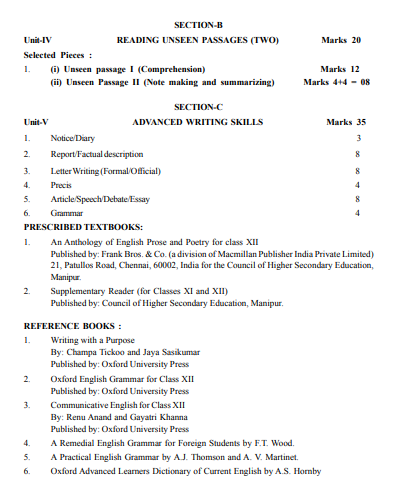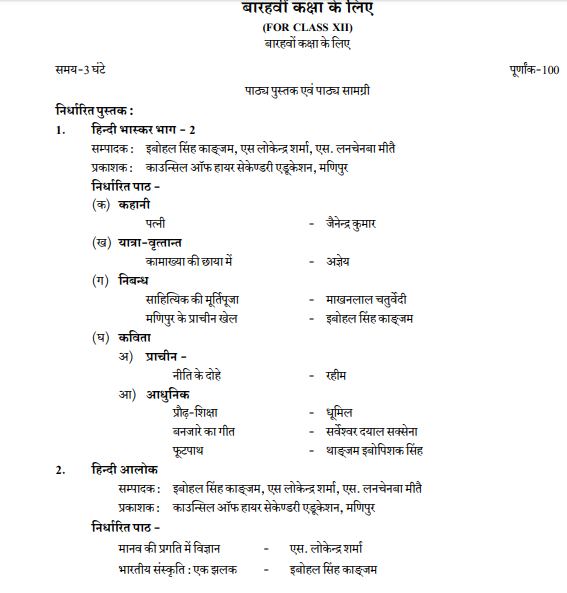
Manipur 12th Syllabus 2025-26: The Council of Higher Secondary Education, Manipur, released the Manipur Class 12 Syllabus 2026 on its official website for all the subjects. The board released the Manipur 12th syllabus 2026 online on its website at cohsem.nic.in. They must visit the official COHSEM website and download the PDFs for the Class 12 Manipur Syllabus. Apart from the official website, students can check the COHSEM class 12 syllabus 2026 on this page. Students preparing for the Manipur Class 12 examinations must go through the entire Manipur HSE syllabus 2026 and complete the same well on time. Manipur 12th syllabus 2026 includes chapter-wise topics from which the questions will be asked in the exam. Students are suggested to complete the entire syllabus for a better performance in the exam.
The Manipur Board Class 12 examinations 2026 will be conducted in February and March 2026.
Given below is the subject-wise COHSEM Manipur Board Class 12 Syllabus 2025-26:
- Manipur Board 12th Syllabus 2026 for Physics
- Manipur Board 12th Syllabus 2025-26 for Chemistry
- Manipur Board 12th Syllabus 2025-26 for Economics
- Manipur Class 12 Syllabus 2026 for Business Studies
- Manipur Board 12th Syllabus 2026 for English
- Manipur Board Class 12 Syllabus 2026 for Hindi
- COHSEM Manipur Syllabus 2025-26: How to download?
Manipur Board 12th Syllabus 2026 for Physics
Commonly asked questions
Yes, in the COHSEM offer many vocational and skill-based subjects in its Manipur 12th class. These subjects include IT, Healthcare, Tourism, Retail, and more. Through these subjects, the board aim to prepare the students job-ready right after the class 12 exams. They also help in developing useful skills apart from academic knowledge. Students interested in these areas should consult their school for available options.
The board releases the updated Manipur 12th syllabus online on its website. To download the latest COHSEM 12th syllabus, the students need to visit the official website at cohsem.nic.in. Apart from the official website, we have also provided the direct links to download the subject-wise Manipur 12th syllabus on this page.
Manipur Board 12th Syllabus 2025-26 for Chemistry
Manipur Class 12th Syllabus 2025 for Biology
| Unit |
Important Topics |
Marks |
|---|---|---|
| Reproduction |
|
14 |
| Genetics and Evolution |
|
18 |
| Biology and Human Welfare |
|
14 |
| Biotechnology |
|
10 |
| Ecology |
|
14 |
Commonly asked questions
Multiple Choice Questions (MSQs) always play a cruicial role in any board exams. Inclass 10, 12 board exams, MCQs are asked in each paper that contain 30% to 40% marks. Through, MCQs, the students are tested for their knoledge and understanding of concepts. Each MCQ usually has one mark, hence, answering them correctly can award boost to your score. These MCQs also take less time to answer if the studtnts are well-prepared.
Manipur Board 12th Syllabus 2025-26 for Economics
| Units |
Important Topics |
Marks |
|---|---|---|
| PART – I: Macro Economics |
|
|
| Introduction |
|
5 |
| National Income and Related Aggregates: Basic Concepts and Measurement |
|
12 |
| Theory of Income and Employment: Basic Concepts and Determination of Income and Employment. |
|
15 |
| Money and Banking |
|
10 |
| Monetary Policy, Fiscal Policy and Government Budget |
|
8 |
| PART – II: Indian Economic Development |
||
| Introduction |
|
5 |
| Structural Changes in the Indian Economy After Liberalization |
|
12 |
| Current Challenges facing Indian Economy |
|
15 |
| Planning and Economic Development in India |
|
10 |
| Economic Growth and Development |
|
8 |
| Total | 100 |
|
Commonly asked questions
To prepare for the Manipur 12th exams, the students need to first obtain and understand the official syllabus. Thereafter, the students should make a daily study timetable covering the entire syllabus. Students must make sure that the entire COHSEM syllabus is covered at least a month before the exams. It will give students enough time to revise it and also practice the sample papers and past year's question papers.
Yes, time to time, COHSEM revises the Manipur 12th syllabus to align with the national education standard. They also make changes in the syllabus as per the prescription made by the state government. However, it happen only sometimes, not every year. While revising the syllabus, the board include the new topic/chapter or remove the certain topics. This year, the board has not made any changes in the Manipur HSC syllabus.
Manipur Class 12 Syllabus 2026 for Business Studies
| Units |
Important Topics |
Marks |
|---|---|---|
| Nature and Significance of Management |
(a) Management – Concept, Objective, Importance. (b) Management as Science, Art, Profession. (c) Levels of Management. (d) Management Functions – Planning, Organising, Staffing, Directing and Controlling. (e) Coordination – Characteristics and Importance. |
7 |
| Principles of Management |
Principles of Management – Concept, Nature and Significance. (b) Fayol’s Principles of Management. (c) Taylor’s Scientific Management – Principles and Techniques. |
7 |
| Business Environment |
a) Business Environment – Concept, Importance. (b) Dimensions of Business Environment – Economic, Social, Technological, Political and Legal. (c) Concept of Liberalization, Privatization and Globalization Business and Industry. (d) Impact of Government Policy, Changes on Business and Industry with special reference to Liberalization, Privatization, Globalisation |
7 |
| Planning |
(a) Concept, Importance, Limitations. (b) Planning Process. (c) Types of plans – Objective, Strategy, Policy, Procedure, Method, Rule, Budget, Programme. |
6 |
| Organising |
(a) Concept and importance. (b) Steps in the process of Organising. (c) Structure of Organisation – Functional and Divisional. (d) Formal and Informal Organisation. (e) Delegation: Concept, Elements and Importance. (f) Decentralization: Concept and Importance. |
10 |
| Staffing |
(a) Concept and Importance of staffing. (b) Staffing as a part of Human Resource Management. (c) Staffing Process: Recruitment – Meaning and Sources: Selection – Process (d) Training and Development – Concept and Importance. |
10 |
| Directing |
(a) Concept and Importance. (b) Elements of Directing – Supervision – Concept, Functions of a Supervisor. |
8 |
| Controlling |
(a) Concept and Importance. (b) Relationship between Planning and Controlling. (c) Steps in the process of Control. |
5 |
| Financial Management |
(a) Concept, Objective of financial management. (b) Decisions relating to Investment, Financing and Dividend. (c) Financial Planning: Concept and Importance (d) Financial Structure – Concept and Factors affecting (e) Fixed and Working capital – Concept and Factors affecting its requirements. |
12 |
| Financial Markets |
(a) Financial Markets: Concept and Types. (b) Money market and its Instruments. (c) Capital market and its types (Primary and Secondary). (d) Stock Exchange – Functions, Trading Procedure (NSDL and CDSL). (e) NSEI – Objectives. (f) Securities Exchange Board of India (SEBI) – Objectives and Functions. |
6 |
| Marketing Management |
(a) Marketing – Meaning, Functions, Marketing v/s Selling. (b) Marketing Management Philosophies. (c) Marketing Mix – Concept. • Product – Concept, Branding, Labeling and Packaging. • Price – Factors determining price. • Physical Distribution – Concept, Channels of distribution: Types, Choice of channels. • Promotion – Concept and Elements; Advertising – Concept, role, Objections against Advertising, Personal selling – Concept and Qualities of a good salesman, Sales Promotion – Concept and Techniques, Publicity – Concept and Role. |
16 |
| Consumer Protection |
(a) Concept and Importance of Consumer Protection. (b) Consumer Protection Act 1986. – Meaning of Consumer and consumer protection. – Rights and Responsibilities of consumers – Who can file a complaint and against whom? – Redressal Machinery. – Remedies available. (c) Consumer Awareness – Role of consumer organizations and NGOs. |
6 |
|
|
Project Work (to be conducted by the institution) |
|
Commonly asked questions
In the Manipur 12th exams, all the major subjects are offered in Arts, Science, and Commerce streams. Students need to select the subjects while getting enrolled in the Manipur 11th class. In science stream, the students can select subjects from Physics, Chemistry, Biology, and Mathematics while in Commerce stream, the students can opt subjects from Accountancy, Economics, and Business Studies. On the other han, students who want to opt art stream in class 11 can choose subjects from History, Political Science, Socialogy, Geography, etc.
Manipur Board class 12 syllabus is sometimes updated to match new education policies or reduce student stress. This year and also last year, the board din not make any changes in the Manipur 12th syllabus.Students should regularly visit the official website of COHSEM for the latest syllabus updates. Schools also provide the revised Manipur HSC syllabus at the beginning of the session. Students should obtain the updated Manipur 12th syllabus and follow it for the preparation of the exams.
Manipur Board 12th Syllabus 2026 for English
Manipur Board Class 12 Syllabus 2026 for Hindi
COHSEM Manipur Syllabus 2025-26: How to download?
- Visit the Manipur board's website at cohsem.nic.in.
- Click on the subject for which the syllabus needs to be downloaded.
- The PDF for Manipur Board Class 12 Syllabus 2026 will open on the screen.
- Download the same and secure it for future uses.
Explore subject-wise topics asked in Manipur 12th
Select your preferred subject
Explore top 12th exams
10 Nov '25 - 8 Apr '26 | KIITEE 2026 Registration - Pha... |
24 Oct '25 - 31 Mar '26 | VITEEE 2026 application form |
3 Nov '25 - 16 Apr '26 | SRMJEEE 2026 Registration (Pha... |
Mar '26 | JMI Entrance Exam 2026 Applica... |
8 Dec '25 - 6 Jan '26 | NIFT 2026 application form OPE... |
16 Aug '25 - 19 Aug '25 | IISER 2025 Round 4 Seat Allotm... |
Manipur 12th Exam
Student Forum
Popular Courses After 12th
Exams accepted
CA FoundationExams accepted
ICSI ExamExams accepted
BHU UET | GLAET | GD Goenka TestBachelor of Business Administration & Bachelor of Law
Exams accepted
CLAT | LSAT India | AIBEExams accepted
IPMAT | NMIMS - NPAT | SET
Exams accepted
BHU UET | KUK Entrance Exam | JMI Entrance ExamBachelor of Design in Animation (BDes)
Exams accepted
UCEED | NIFT Entrance Exam | NID Entrance ExamBA LLB (Bachelor of Arts + Bachelor of Laws)
Exams accepted
CLAT | AILET | LSAT IndiaBachelor of Journalism & Mass Communication (BJMC)
Exams accepted
LUACMAT | SRMHCAT | GD Goenka Test

 Exam On - 17 Feb '26 - 20 Mar '26
Exam On - 17 Feb '26 - 20 Mar '26


